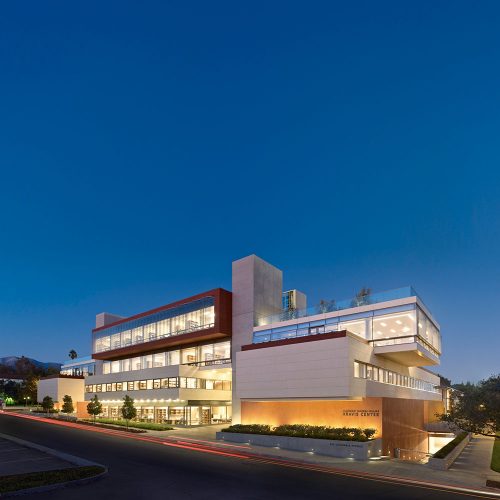Bard College, Reem and Kayden Center for Science and Computation
A building for practicing and teaching the sciences is built around a public atrium and flooded with dappled light and panoramic views of the surrounding forest.
The Reem and Kayden Center for Science and Computation highlights Bard College’s increased commitment to the integration of the sciences into its liberal arts curriculum. The 6,410-square-meter (69,000-square-foot) building provides space for the biology, chemistry, computer science, and mathematics departments in a facility equipped with state-of-the-art teaching and research laboratories, high-tech classrooms, and a 60-person auditorium.
Constructed in a prominent, central campus location, the design solution for this program paid close attention to site planning, as well as, spatial composition to encourage student-faculty interaction in informal spaces. Conceived for its context, the Center is a gently curving metal-clad structure set low to the ground in a clearing. Cantilevered over an axis generated by the campus walk, the building establishes a visual connection with the heart of the College grounds and allows the path to continue. Respectful of its natural environment, it is both multifunctional and inspirational.
The Center’s design incorporates glass exterior walls, a large atrium, and an open-floor plan featuring flexible, multidisciplinary spaces for teaching, research, and discussion. The building is organized around a central spine that contains vertical circulation, support spaces, and MEP distribution services, negotiating between the teaching and research laboratories to the west and public spaces to the east. Vestibules pass through the spine from the lobby to access the laboratories, which were designed to be large and open interactive spaces shared by students and faculty. The laboratories are equipped with moveable benches and a customized bollard system that provide flexible distribution of the infrastructure utilities necessary for advanced scientific study and research. Such flexibility allows for easy reconfiguration to accommodate new initiatives.
All of the laboratory spaces face a wooded area to the west through a full-height curtain wall system that stretches the length of the building. Within the lobby and overlooking the undulating landscape to the east, four freestanding pods clad in copper, stainless steel, and zinc contain an auditorium, two lecture rooms, and a seminar room, with public gathering areas situated between them. Faculty offices cantilever above the lobby on the second floor and are accessed via an open corridor that overlooks the lobby and expands to study terraces above the pods.
































